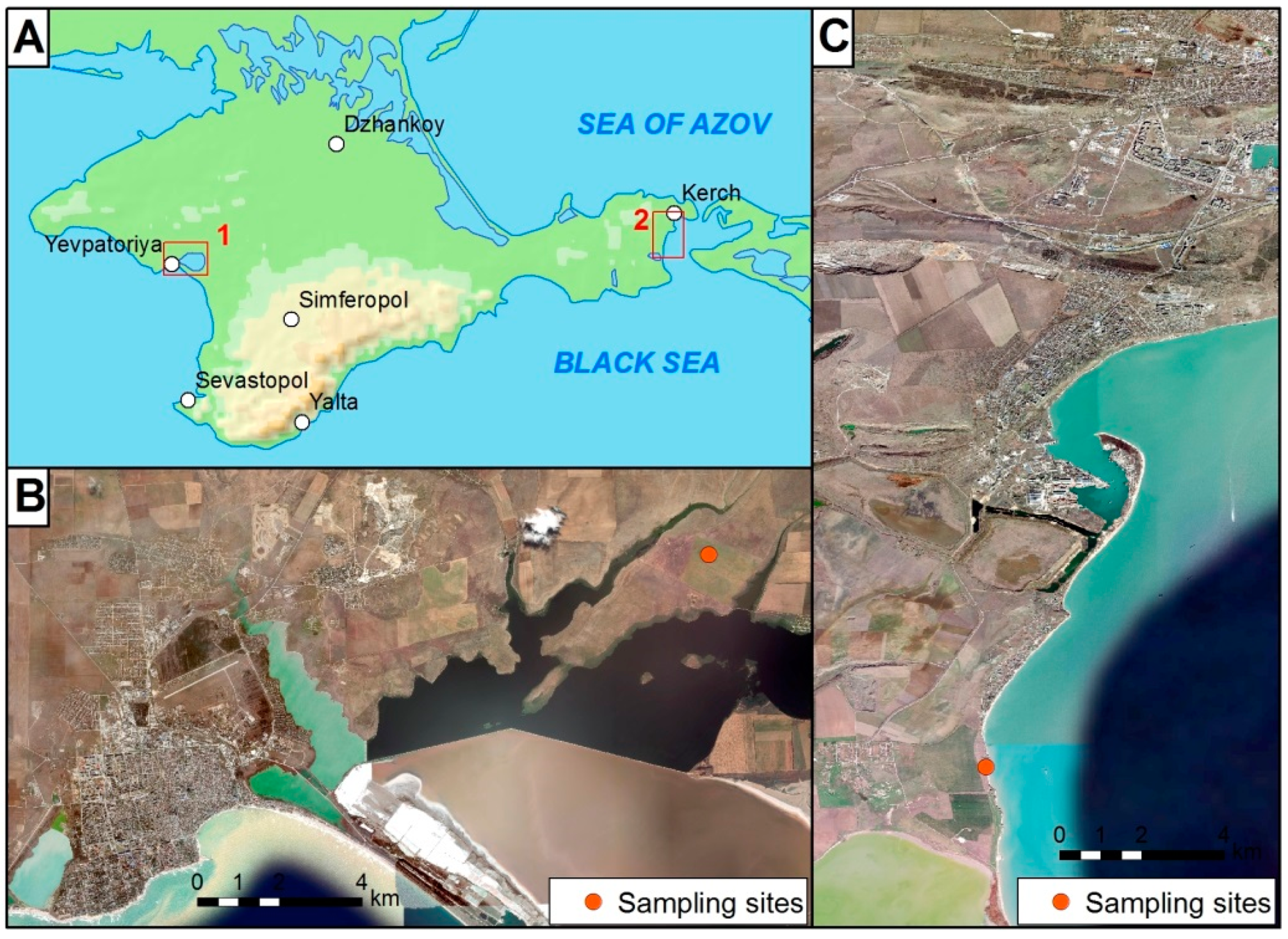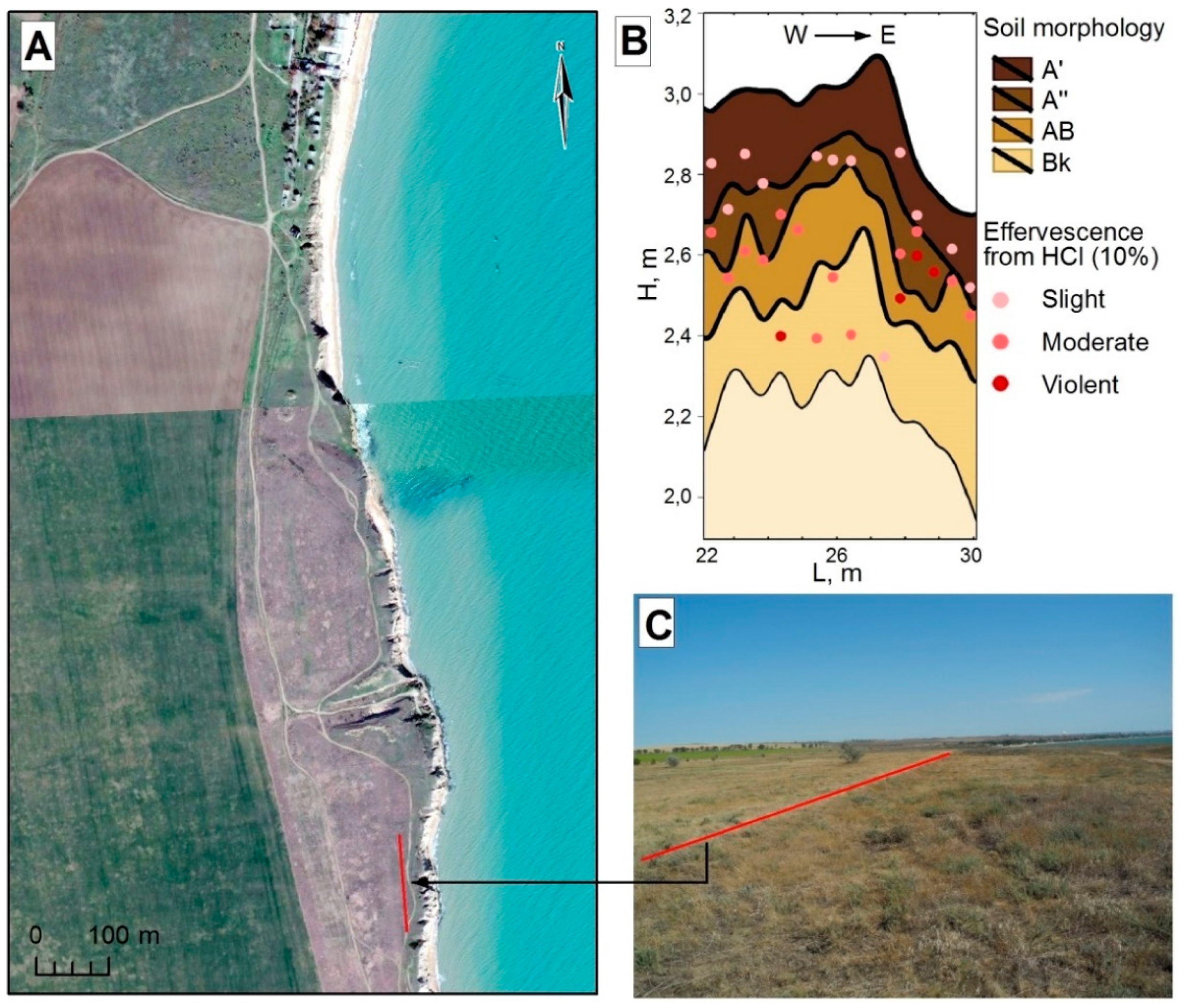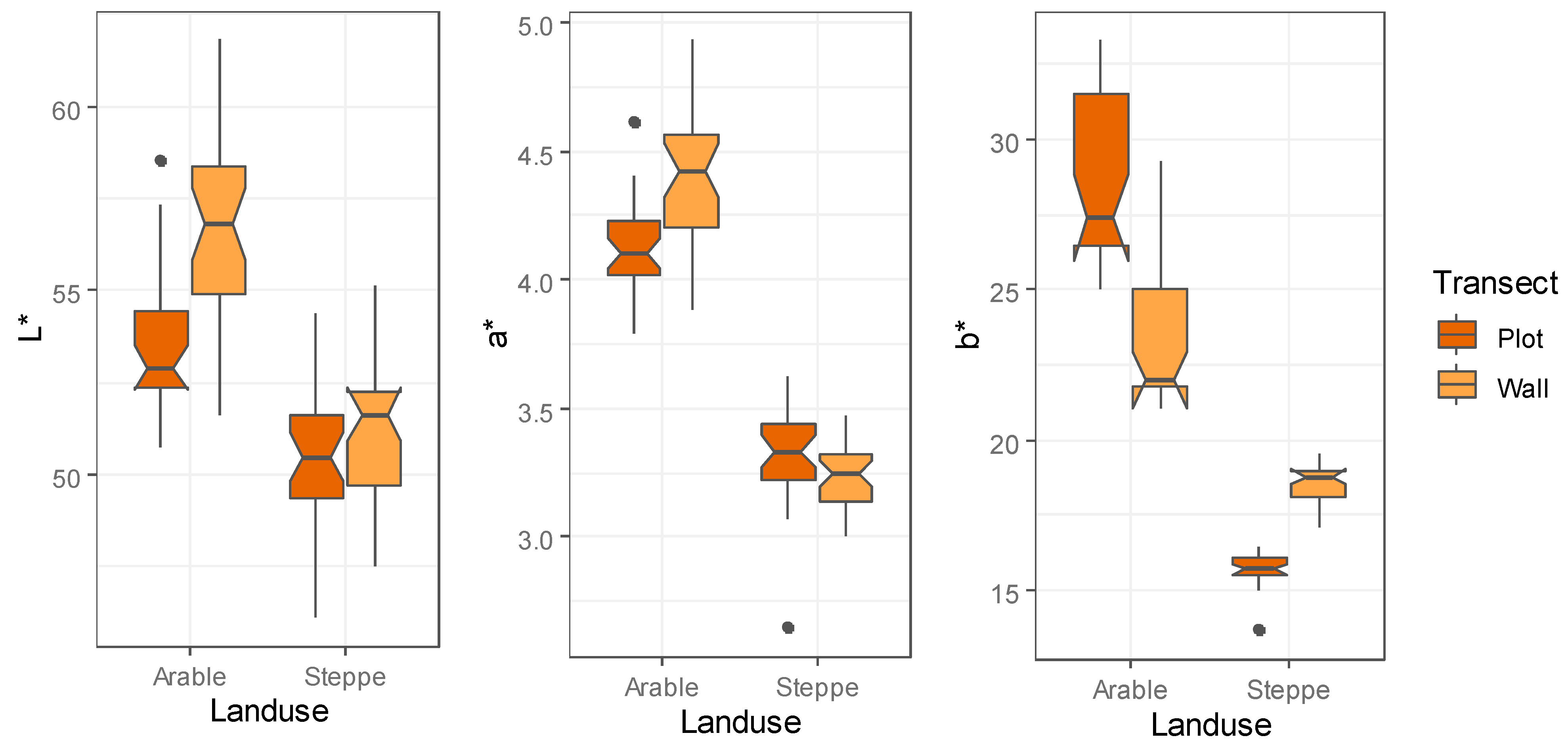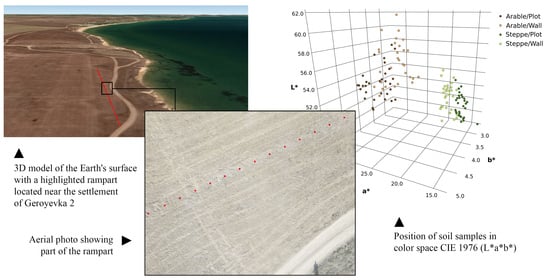Differentiating Soils from Arable and Fallow Land Using Spectrometry
Abstract
:1. Introduction
2. Study Area
3. Materials and Methods
- -
- spectrometer AvaSpec-2048;
- -
- standard light source AvaLight-DHc;
- -
- bifurcation fiber optic cable;
- -
- standard white WS-2;
- -
- a computer with AvaSoft 8.10 full installed, including the AvaSoft-COL module.
4. Results and Discussion
5. Conclusions
Author Contributions
Funding
Institutional Review Board Statement
Informed Consent Statement
Acknowledgments
Conflicts of Interest
References
- Smekalova, T.N.; Terekhin, E.A.; Pasumanskiy, A.E.; Lisetskii, F.N. Using of historical cartography, remote sensing data and GIS for studying of land division system of Taurian Chersonesos. InterCarto InterGIS 2020, 26, 177–187. [Google Scholar] [CrossRef]
- Trelogan, J.; Crawford, M.; Teng, L.; Kwon, O.; Carter, J. Mapping the features of the chora of Chersonesos via remotely sensed data. In Proceedings of the IEEE 1999 International Geoscience and Remote Sensing Symposium (IGARSS’99), Hamburg, Germany, 28 June–2 July 1999; Stein, T.I., Ed.; IEEE: New York, NY, USA, 1999; Volume 5, pp. 2569–2571. [Google Scholar]
- Carter, J.C.; Crawford, M.; Lehman, P.; Nikolaenko, G.; Trelogan, J. The Chora of Chersonesos in Crimea, Ukraine. Am. J. Archaeol. 2000, 104, 707–741. [Google Scholar] [CrossRef]
- Stolba, V.F.; Andresen, J. Unveiling the hinterland: A new type of Hellenistic rural settlement in Crimea. Antiquity 2015, 89, 345–360. [Google Scholar] [CrossRef] [Green Version]
- Viscarra Rossel, R.A.; Fouad, Y.; Walter, C. Using a digital camera to measure soil organic carbon and iron contents. Biosyst. Eng. 2008, 100, 149–159. [Google Scholar] [CrossRef]
- Bulygin, S.Y.; Bidolakh, D.I.; Lisetskii, F.N. Assessment of soil humus content using their digistal images. Nauch. Ved. Belgorod. Gos. Univ. Ser. Estestv. Nauki. 2011, 16, 154–159. [Google Scholar]
- Pérez, F.L. Plant organic matter really matters: Pedological effects of kūpaoa (dubautia menziesii) shrubs in a volcanic alpine area, Maui, Hawai’i. Soil Syst. 2019, 3, 31. [Google Scholar] [CrossRef] [Green Version]
- Kirillova, N.P.; Zhang, Y.; Hartemink, A.E.; Zhulidova, D.A.; Artemyeva, Z.S.; Khomyakov, D.M. Calibration methods for measuring the color of moist soils with digital cameras. Catena 2021, 202, 105274. [Google Scholar] [CrossRef]
- Schmidt, S.A.; Ahn, C. Analysis of soil color variables and their relationships between two field-based methods and its potential application for wetland soils. Sci. Total Environ. 2021, 783, 147005. [Google Scholar] [CrossRef] [PubMed]
- Demattê, J.A.; Campos, R.C.; Alves, M.C.; Fiorio, P.R.; Nanni, M.R. Visible–NIR reflectance: A new approach on soil evaluation. Geoderma 2004, 121, 95–112. [Google Scholar] [CrossRef]
- Bellinaso, H.; Demattê, J.A.M.; Romeiro, S.A. Soil spectral library and its use in soil classification. Rev. Bras. Ciência Solo 2010, 34, 861–870. [Google Scholar] [CrossRef] [Green Version]
- Summers, D.; Lewis, M.; Ostendorf, B.; Chittleborough, D. Visible near-infrared reflectance spectroscopy as a predictive indicator of soil properties. Ecol. Indic. 2011, 11, 123–131. [Google Scholar] [CrossRef]
- Gholizadeh, A.; Amin, M.S.M.; Borůvka, L.; Saberioon, M.M. Models for estimating the physical properties of paddy soil using visible and near infrared reflectance spectroscopy. J. Appl. Spectrosc. 2014, 81, 534–540. [Google Scholar] [CrossRef]
- Gore, R.D.; Chaudhari, R.H.; Gawali, B.W. Creation of Soil Spectral Library for Marathwada Region. Int. J. Adv. Remote Sens. GIS 2016, 5, 1787–1794. [Google Scholar] [CrossRef]
- Konen, M.E.; Burras, C.L.; Sandor, J.A. Organic carbon, texture, and quantitative color measurement relationships for cultivated soils in north central Iowa. Soil Sci. Soc. Am. J. 2003, 67, 1823–1830. [Google Scholar] [CrossRef]
- Sánchez-Marañón, M.; Delgado, G.; Melgosa, M.; Hita, E.; Delgado, R. CIELAB color parameters and their relationship to soil characteristics in Mediterranean red soils. Soil Sci. 1997, 162, 833–842. [Google Scholar] [CrossRef] [Green Version]
- Gunal, H.; Ersahin, S.; Yetgin, B.; Kutlu, T. Use of chromameter-measured color parameters in estimating color-related soil variables. Commun. Soil Sci. Plant Anal. 2008, 39, 726–740. [Google Scholar] [CrossRef]
- Ibáñez-Asensio, S.; Marqués-Mateu, A.; Moreno-Ramón, H.; Balasch, S. Statistical relationships between soil colour and soil attributes in semiarid areas. Biosyst. Eng. 2013, 116, 120–129. [Google Scholar] [CrossRef]
- Moreno-Ramón, H.; Marqués-Mateu, Á.; Ibáñez-Asensio, S. Significance of soil lightness versus physicochemical soil properties in semiarid areas. Arid Land Res. Manag. 2014, 28, 371–382. [Google Scholar] [CrossRef] [Green Version]
- Zinko, V.N. Geroevka-2. A rural settlement in the chora of Nimphaion (Ancient period). Archeol. Warshawa 1997, XLVII, 35–94. [Google Scholar]
- Zubarev, V.G.; Smekalov, S.L. Map of archaeological sites tracts Adzhiel in the eastern Crimea, according to different sources. Mod. Appl. Sci. 2014, 9, 184–191. [Google Scholar] [CrossRef] [Green Version]
- Lisetskii, F.; Stolba, V.; Golyeva, A.; Marinina, O.; Poletaev, A. Postantique soils as a source of land use information: A case study of an ancient Greek agricultural area on the Northern Black Sea Coast. Appl. Environ. Soil Sci. 2020, 2020, 8698179. [Google Scholar] [CrossRef] [Green Version]
- Lisetskii, F.N.; Poletaev, A.O.; Terekhin, E.A.; Marinina, O.A. Soil-genetic differences of multi-aged fallow lands in an ancient agricultural region of steppe Crimea. IOP Conf. Ser. Earth Environ. Sci. 2021, 817, 012061. [Google Scholar] [CrossRef]
- Smekalova, T.N.; Kutaisov, V.A. Role of Chersonessian polis in the development of north-west Tauris in Hellenistic time. Strat. Plus 2018, 3, 353–370. [Google Scholar]
- Arinushkina, E.V. Manual on the Chemical Analysis of Soils; 1970; Available online: https://agris.fao.org/agris-search/search.do?recordID=US201300468313 (accessed on 31 August 2021).
- Munsell, A. Munsell Soil Color Charts; Revised Edition; Gretag Macbeth: New Windsor, NY, USA, 1994. [Google Scholar]
- Lisetskii, F. Estimates of soil renewal rates: Applications for anti-erosion arrangement of the agricultural landscape. Geosciences 2019, 9, 266. [Google Scholar] [CrossRef] [Green Version]
- Lisetskii, F.N.; Stolba, V.F.; Goleusov, P.V. Modeling of the evolution of steppe Chernozems and development of the method of pedogenetic chronology. Eurasian Soil Sci. 2016, 49, 846–858. [Google Scholar] [CrossRef] [Green Version]
- Torrent, J.; Barrón, V. Laboratory measurement of soil color: Theory and practice. In Soil Color; SSSA Special Publications; SSSA: Madison, WI, USA, 1993; Volume 31, pp. 21–33. [Google Scholar] [CrossRef]
- Robertson, A.R. The CIE 1976 color-difference formulae. Color Res. Appl. 1977, 2, 7–11. [Google Scholar] [CrossRef]
- Ohno, Y. CIE fundamentals for color measurements. In International Conference on Digital Printing Technologies, Vancouver, Canada, 16–20 October 2000; Society for Imaging Science and Technology: Springfield, IL, USA, 2000; pp. 540–545. [Google Scholar]
- Rossel, R.V.; Minasny, B.; Roudier, P.; Mcbratney, A.B. Colour space models for soil science. Geoderma 2006, 133, 320–337. [Google Scholar] [CrossRef]
- Vodyanitskii, Y.N.; Kirillova, N.P. Application of the CIE-L*a*b* system to characterize soil color. Eurasian Soil Sci. 2016, 49, 1259–1268. [Google Scholar] [CrossRef]
- R Core Team. R: A Language and Environment for Statistical Computing; R Foundation for Statistical Computing: Vienna, Austria, 2021; Available online: https://www.R-project.org/ (accessed on 20 July 2021).
- Racine, J.S. RStudio: A platform-independent IDE for R and Sweave. J. Appl. Econom. 2012, 27, 167–172. [Google Scholar] [CrossRef]
- Anderson, M.J. A new method for non-parametric multivariate analysis of variance. Austral Ecol. 2001, 26, 32–46. [Google Scholar] [CrossRef]
- Kruskal, W.H.; Wallis, W.A. Use of ranks in one-criterion variance analysis. J. Am. Stat. Assoc. 1952, 47, 583–621. [Google Scholar] [CrossRef]
- Mann, H.B.; Whitney, D.R. On a test of whether one of two random variables is stochastically larger than the other. Ann. Math. Stat. 1947, 18, 50–60. [Google Scholar] [CrossRef]
- Wright, S.P. Adjusted P-Values for Simultaneous Inference. Biometrics 1992, 48, 1005–1013. [Google Scholar] [CrossRef]
- Oksanen, J.; Blanchet, F.G.; Friendly, M.; Kindt, R.; Legendre, P.; McGlinn, D.; Minchin, P.R.; O’Hara, R.B.; Simpson, G.L.; Solymos, P.; et al. Vegan: Community Ecology Package. R Package Version 2.5-4. 2019. Available online: https://CRAN.R-project.org/package=vegan (accessed on 20 July 2021).
- Doornik, J.A.; Hansen, H. An Omnibus test for univariate and multivariate normality. Oxf. Bull. Econ. Stat. 2008, 70, 927–939. [Google Scholar] [CrossRef]
- Korkmaz, S.; Goksuluk, D.; Zararsiz, G. MVN: An R Package for Assessing Multivariate Normality. R J. 2014, 6, 151–162. [Google Scholar] [CrossRef] [Green Version]
- McArdle, B.H.; Anderson, M.J. Fitting multivariate models to community data: A comment on distance-based redundancy analysis. Ecology 2001, 82, 290–297. [Google Scholar] [CrossRef]
- Holm, S. A simple sequentially rejective multiple test procedure. Scand. J. Stat. 1979, 6, 65–70. [Google Scholar]
- Valeeva, A.A.; Aleksandrova, A.B.; Koposov, G.F. Color estimation of forest-steppe soils by digital photography under laboratory conditions. Eurasian Soil Sci. 2016, 49, 1033–1037. [Google Scholar] [CrossRef]
- Kirillova, N.P.; Kemp, D.B.; Artemyeva, Z.S. Colorimetric analysis of soil with flatbed scanners. Eur. J. Soil Sci. 2017, 68, 420–433. [Google Scholar] [CrossRef]
- Kirillova, N.P.; Sileva, T.M. Colorimetric analysis of soils using digital cameras. Mosc. Univ. Soil Sci. Bull. 2017, 72, 13–20. [Google Scholar] [CrossRef]




| No Plot | 56 | 57 | 58 |
|---|---|---|---|
| Depth (cm) | 4.5–17 | 5.2–17 | 5–17 |
| Bulk density (g cm−3) | 1.30 | 0.96 | 1.06 |
| Munsell color (dry) | 10YR 4/2.5 | 10YR 4/2.5 | 10YR 4/3 |
| Humus (%) | 2.5 | 3.0 | 3.9 |
| P2O5 (mg·kg−1) | 8 | 7 | 16 |
| K2O (mg·kg−1) | 417 | 455 | 599 |
| pH (H2O) | 8.1 | 8.1 | 8.2 |
| pH (KCl) | 7.1 | 7.0 | 7.1 |
| Total nitrogen (%) | 0.20 | 0.20 | 0.28 |
| Soil cation exchange, (cmol(+)kg−1) | 28.2 | 28.4 | 28.8 |
| Hydrolysable N (mg·kg−1) | 105 | 119 | 140 |
| Cl (mg·kg−1) | 78.4 | 77.2 | 168.5 |
| Na2O (%) | 0.9 | 1.4 | 1.4 |
| S (mg·kg−1) | 560.4 | 613.6 | 775.5 |
| Pb (mg·kg−1) | 18.1 | 15.6 | 28.2 |
| P2O5 (%) | 0.22 | 0.21 | 0.26 |
| Zn (mg·kg−1) | 60.5 | 62.5 | 66.9 |
| As (mg·kg−1) | 17.7 | 19.7 | 14.1 |
| Cu (mg·kg−1) | 33.0 | 26.1 | 27.1 |
| Sample | Minimum | Mean | Median | Maximum | Standard Deviation |
|---|---|---|---|---|---|
| L* | |||||
| Arable/Plot | 50.76 | 53.52 | 52.91 | 58.57 | 2.01 |
| Arable/Wall | 51.59 | 56.69 | 56.82 | 61.81 | 2.59 |
| Steppe/Plot | 46.12 | 50.41 | 50.49 | 54.37 | 1.75 |
| Steppe/Wall | 47.52 | 51.13 | 51.64 | 55.15 | 2.01 |
| a* | |||||
| Arable/Plot | 3.79 | 4.13 | 4.11 | 4.61 | 0.19 |
| Arable/Wall | 3.88 | 4.37 | 4.43 | 4.93 | 0.26 |
| Steppe/Plot | 2.65 | 3.32 | 3.33 | 3.62 | 0.19 |
| Steppe/Wall | 3.00 | 3.23 | 3.25 | 3.47 | 0.13 |
| b* | |||||
| Arable/Plot | 25.03 | 28.47 | 27.41 | 33.28 | 2.65 |
| Arable/Wall | 21.06 | 23.53 | 21.98 | 29.30 | 2.86 |
| Steppe/Plot | 13.67 | 15.71 | 15.69 | 16.47 | 0.55 |
| Steppe/Wall | 17.12 | 18.49 | 18.76 | 19.52 | 0.70 |
| Variable * | df | Sums of Squares | R2 | F | p-Value |
|---|---|---|---|---|---|
| L | 1 | 2964.60 | 0.65 | 388.39 | 0.001 |
| T | 1 | 148.80 | 0.03 | 17.54 | 0.001 |
| L/T | 1 | 492.50 | 0.11 | 58.04 | 0.001 |
| Residuals | 116 | 984.30 | 0.21 | ||
| Total | 119 | 4590.20 | 1.00 |
| Color Coordinate | H | df | p-Value |
|---|---|---|---|
| L* | 71.02 | 3 | 2.58 × 10−15 |
| a* | 94.11 | 3 | <2.20 × 10−16 |
| b* | 105.99 | 3 | <2.20 × 10−16 |
| Arable/Wall | Arable/Plot | Steppe/Wall | |
|---|---|---|---|
| L* | |||
| Arable/Plot | 1.20 × 10−5 | — | — |
| Steppe/Wall | 1.00 × 10−11 | 0.0002 | — |
| Steppe/Plot | 5.20 × 10−14 | 1.00 × 10−6 | 0.76 |
| a* | |||
| Arable/Plot | 0.002 | — | — |
| Steppe/Wall | 1.80 × 10−10 | 1.80 × 10−10 | — |
| Steppe/Plot | 1.80 × 10−10 | 1.80 × 10−10 | 0.06 |
| b* | |||
| Arable/Plot | 1.60 × 10−5 | — | — |
| Steppe/Wall | 1.80 × 10−10 | 1.80 × 10−10 | — |
| Steppe/Plot | <2.20 × 10−16 | 1.80 × 10−10 | 1.80 × 10−10 |
Publisher’s Note: MDPI stays neutral with regard to jurisdictional claims in published maps and institutional affiliations. |
© 2021 by the authors. Licensee MDPI, Basel, Switzerland. This article is an open access article distributed under the terms and conditions of the Creative Commons Attribution (CC BY) license (https://creativecommons.org/licenses/by/4.0/).
Share and Cite
Ukrainskiy, P.; Lisetskii, F.; Poletaev, A. Differentiating Soils from Arable and Fallow Land Using Spectrometry. Soil Syst. 2021, 5, 54. https://doi.org/10.3390/soilsystems5030054
Ukrainskiy P, Lisetskii F, Poletaev A. Differentiating Soils from Arable and Fallow Land Using Spectrometry. Soil Systems. 2021; 5(3):54. https://doi.org/10.3390/soilsystems5030054
Chicago/Turabian StyleUkrainskiy, Pavel, Fedor Lisetskii, and Arseniy Poletaev. 2021. "Differentiating Soils from Arable and Fallow Land Using Spectrometry" Soil Systems 5, no. 3: 54. https://doi.org/10.3390/soilsystems5030054
APA StyleUkrainskiy, P., Lisetskii, F., & Poletaev, A. (2021). Differentiating Soils from Arable and Fallow Land Using Spectrometry. Soil Systems, 5(3), 54. https://doi.org/10.3390/soilsystems5030054









